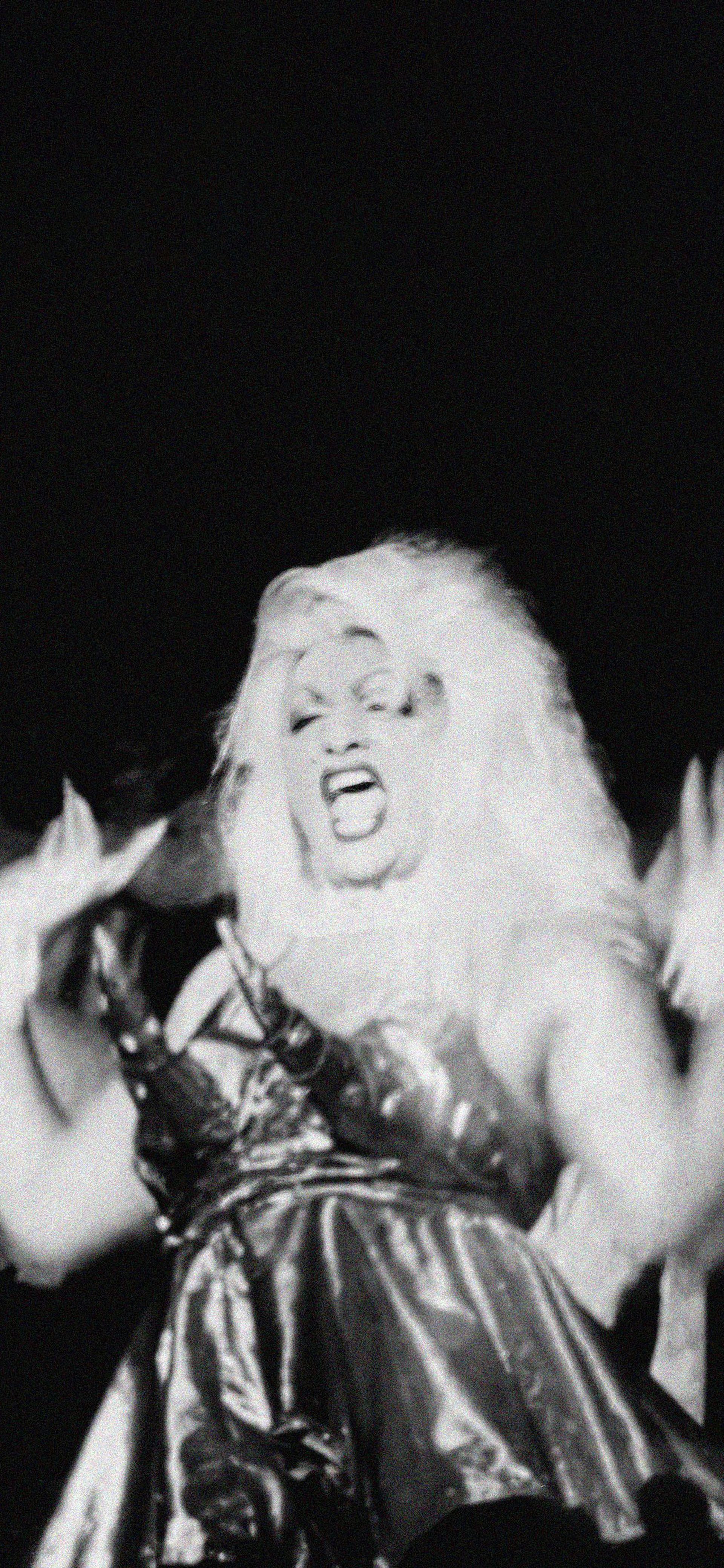BERTHA

‘I have always loved female artists of great stature and body, and wanted to pick a drag name of Wagnerian proportions so I chose Bertha.’
Bertha is the alter-ego of Harold Samu, a proud Sāmoan who identifies as Fa‘afafine. Samu tells his story of Bertha through a series of dolls dressed in outfits he’s worn throughout his drag career. Powerhouse commissioned Yuki Kihara to create the 13 Bertha dolls for the Powerhouse Ultimo iteration of Kihara's Paradise Camp, curated by Natalie King.
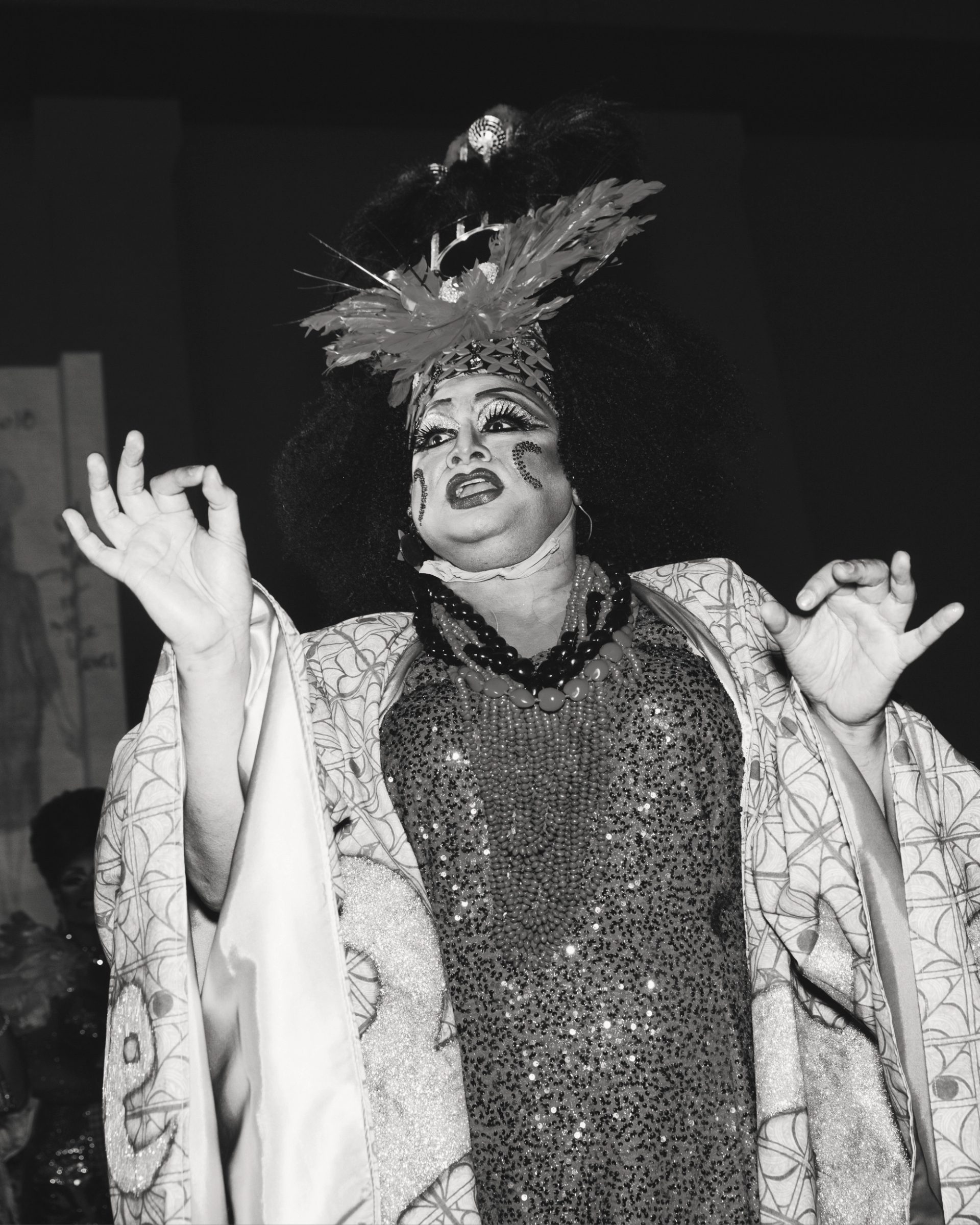
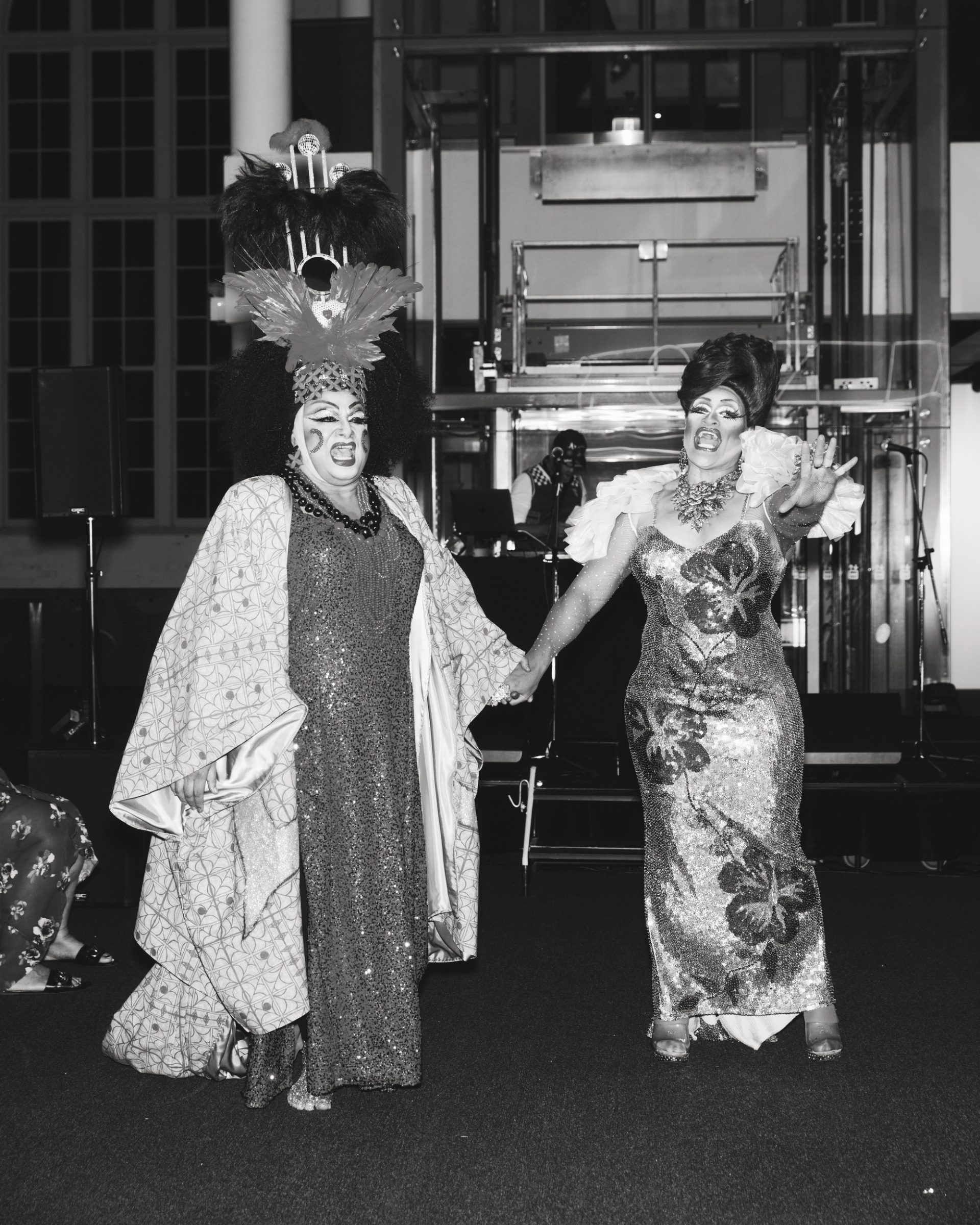
Bertha's Story
'Talofa. My name is Harold Lee Iusitini Samu, born 1961 in the hood of Mangere, Auckland, New Zealand (NZ). My drag name is Bertha. My mother is Tuiloma Molipopo Samu (deceased) née Iusitini: paternal Sāmoan nu’u (villages) are Sapunaoa and Sa’asatele; maternal nu’u are Pu’apu’a and Falelatai. Daughter of London Missionary Society (LMS) ministers, my mother converted to the Latter-Day Saints (Mormon) church before marrying my father. My father is Leatufale Lila Samu (deceased): paternal nu’u is Salelesi; maternal nu’u are Faleula and Iva. I am Fa’afafine. I tell my story through a series of dolls dressed in outfits I’ve worn throughout my drag career.
I have always loved female artists of great stature and body, and wanted to pick a drag name of Wagnerian proportions so I chose Bertha. In the first Sister Act film, Whoopi Goldberg’s character talks about her neighbour named Buckwheat Bertha. I just loved it. My drag sister, Edward Cowley, took the name of Buckwheat and we’ve been connected ever since.
From mid 1980s to early 2000s, I participated in community activism, beginning as soon as I entered the Auckland gay community. I marched for Homosexual Law Reform in NZ in 1986.
I have sat on the boards for the Hero Party/Festival/Parade and the NZ AIDS Foundation. I was a founding member of the AFA group for Pasifika gay men and Fa‘afafine in Auckland in the late 1990s. Probably because both my parents were active in trade unions and workers’ rights, having worked in factories all their lives in New Zealand, I am an activist for workers’ rights. My foci for activism these days are around LGBTQIA rights, particularly transgender rights and climate change.
In a gay sense, challenging gender norms as a man dressing as a woman has been to challenge the patriarchy and societal norms. It is an act as old as humanity. It has been a platform to express my feminine side while entertaining people. It gives expression to characteristics that Harold the Fa‘afafine may not display in real life, like outrageousness and cutting humorous banter.
As a Fa‘afafine, it has been tremendously rewarding to be acknowledged by your community and your queer peers as a person of influence and as a group of influence. Drag is about performance whereas being Fa‘afafine is about gender identity. At the invitation of Yuki Kihara, I reflected on aspects of my life so that each doll captures a different period or moment in my life through costuming.'
– Harold Samu
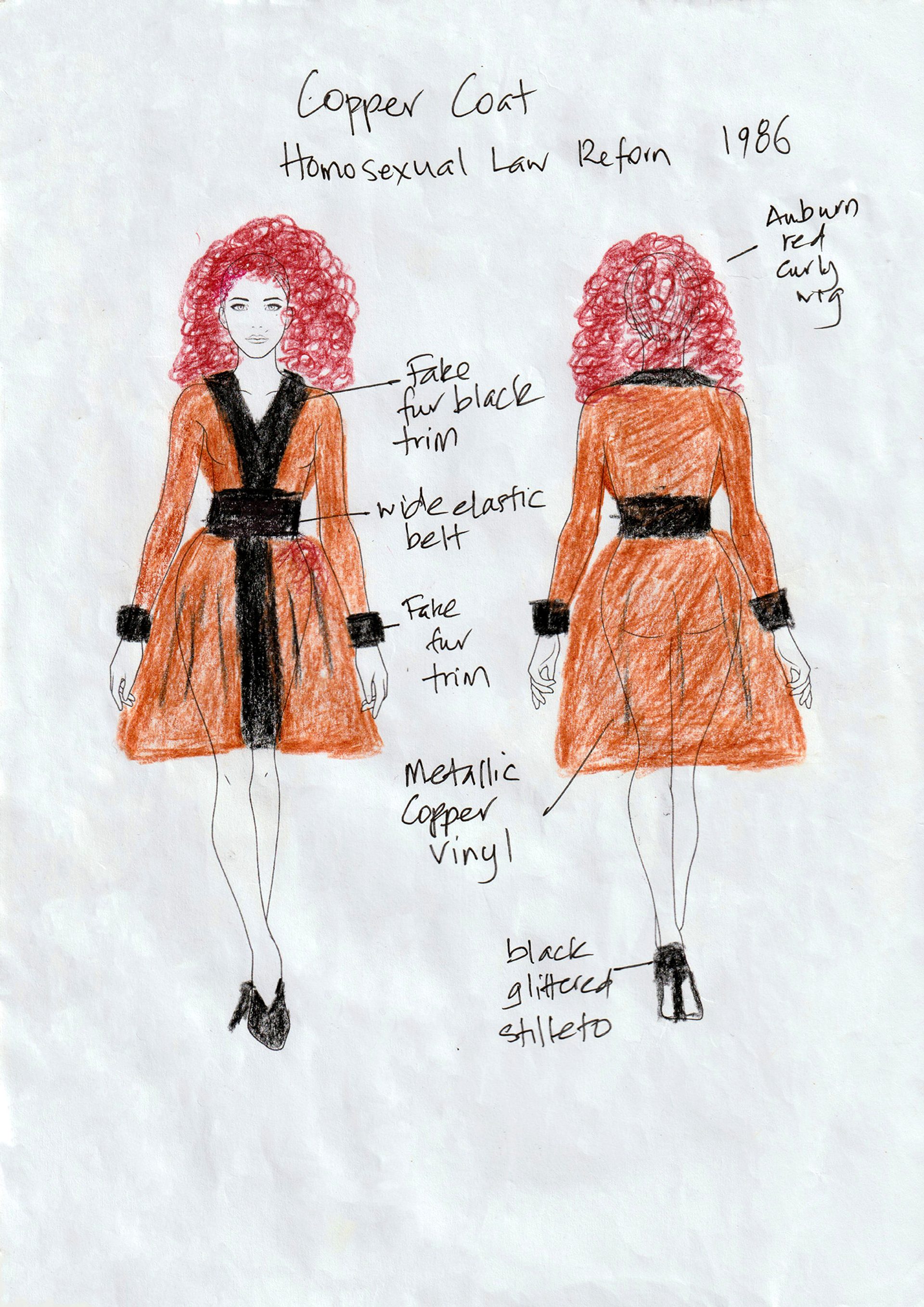
Law Reform Girl 1986 (2023)
The jacket was made by my drag sister Shuvon.
In 1986, the Homosexual Law Reform (HLR) Bill was passed into law decriminalising homosexual acts in NZ. This was the outfit I wore to march down Queen Street, the main road in Auckland’s CBD. I marched in solidarity with my gay, lesbian and trans brothers and sisters and many straight allies. Arm in arm with my drag sisters, we marched and our image ended up on the front page of the NZ Herald. I was courting discovery as I was not yet out to my family.
The HLR Bill was an important step allowing our community to deal with the impending effects of a strange virus decimating gay communities overseas, later called HIV (Human Immunodeficiency Virus).
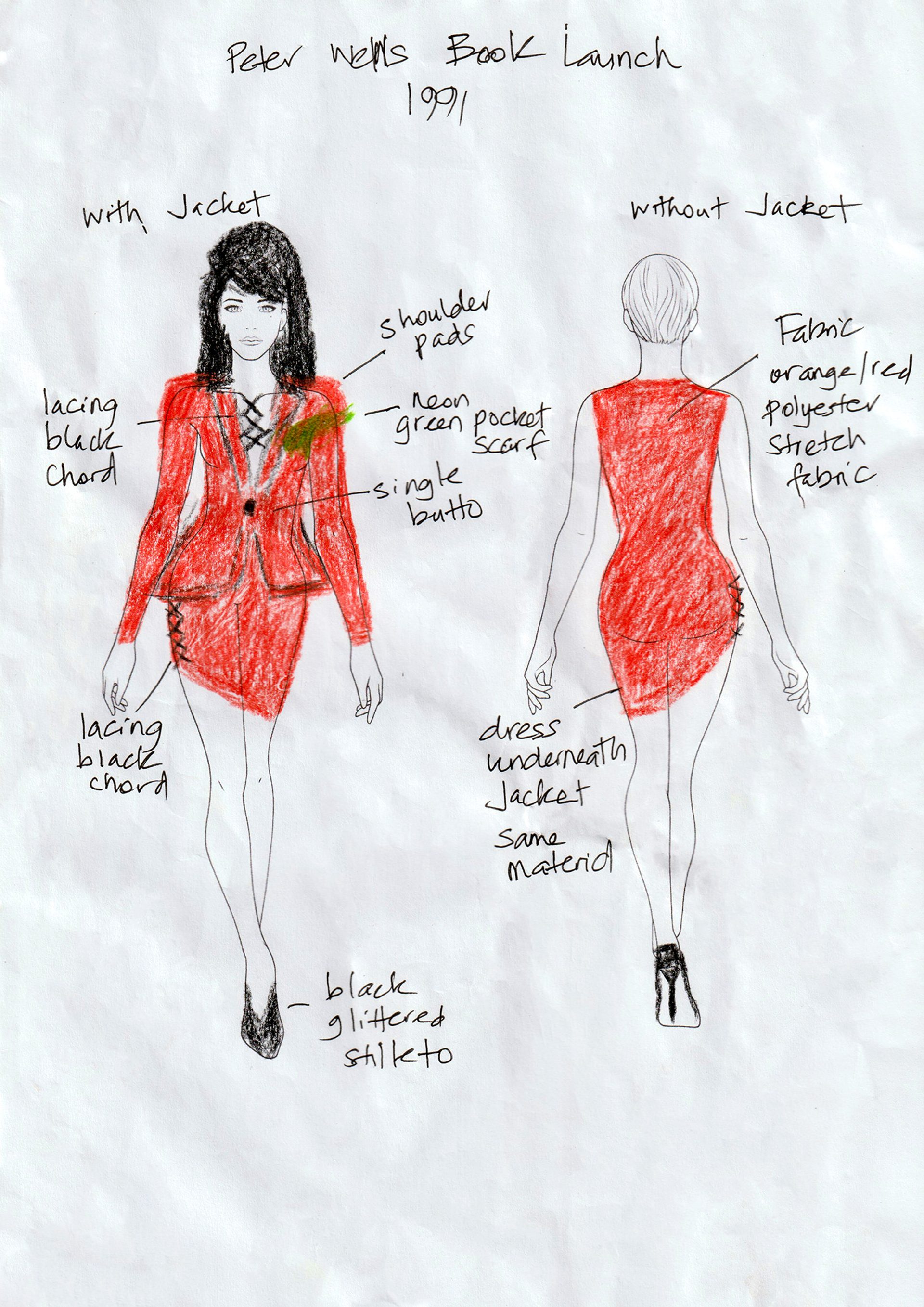
Dangerous Desire 1991 (2023)
My dear friend James Leuii made this suit. In fact he has made a few of the dresses in this line up.
I wore this suit to the book launch of Dangerous Desires written by Peter Wells as I had appeared in his 1987 film, A Death in the Family. He asked me to read an excerpt at the launch, shot by TV3 for its late news program. Unbeknown to me, my parents and younger sisters were watching the program. My mother said, ‘She looks like she could be our aiga (family). ’My mother proclaimed in anguish, ‘It’s all my fault…it’s from my aiga.’ It turned out my mother had two uncles who were Fa‘afafine. We knew of my mother’s uncles who were artistic, musical and well respected, both of whom married and had children.
The next day I went home for the family meeting and came out to my parents. My father was immediately accepting but my mother was not. Over time, she became accepting and even proud.

Take me to Heaven 1992 (2023)
Made by James Leuii, this dress was a baby doll shape with conical breasts strapped on for my number, lip-sync performing to Sylvester’s song Take Me to Heaven.
The Hero Parties began in 1991, organised by the NZ AIDS Foundation to promote condoms for safe sex. I had been involved since their inception, in stage performances and compering. Drag is first and foremost a performance art. Performing at big dance parties with dancers and a wildly appreciative crowd is a drag highlight.
Bertha was birthed from the gay bars and clubs of Auckland. She was a child of the disco, and music was a vital and integral part of drag.
There was no show without the musical artistry to which we lip-synced. My go-to divas were Patti LaBelle, Sylvester, Aretha Franklin, Jennifer Holliday, Jocelyn Brown and Martha Wash. Not for me were artists favoured by the younger queens, the likes of Whitney, Mariah or Kylie (though I loved their music).
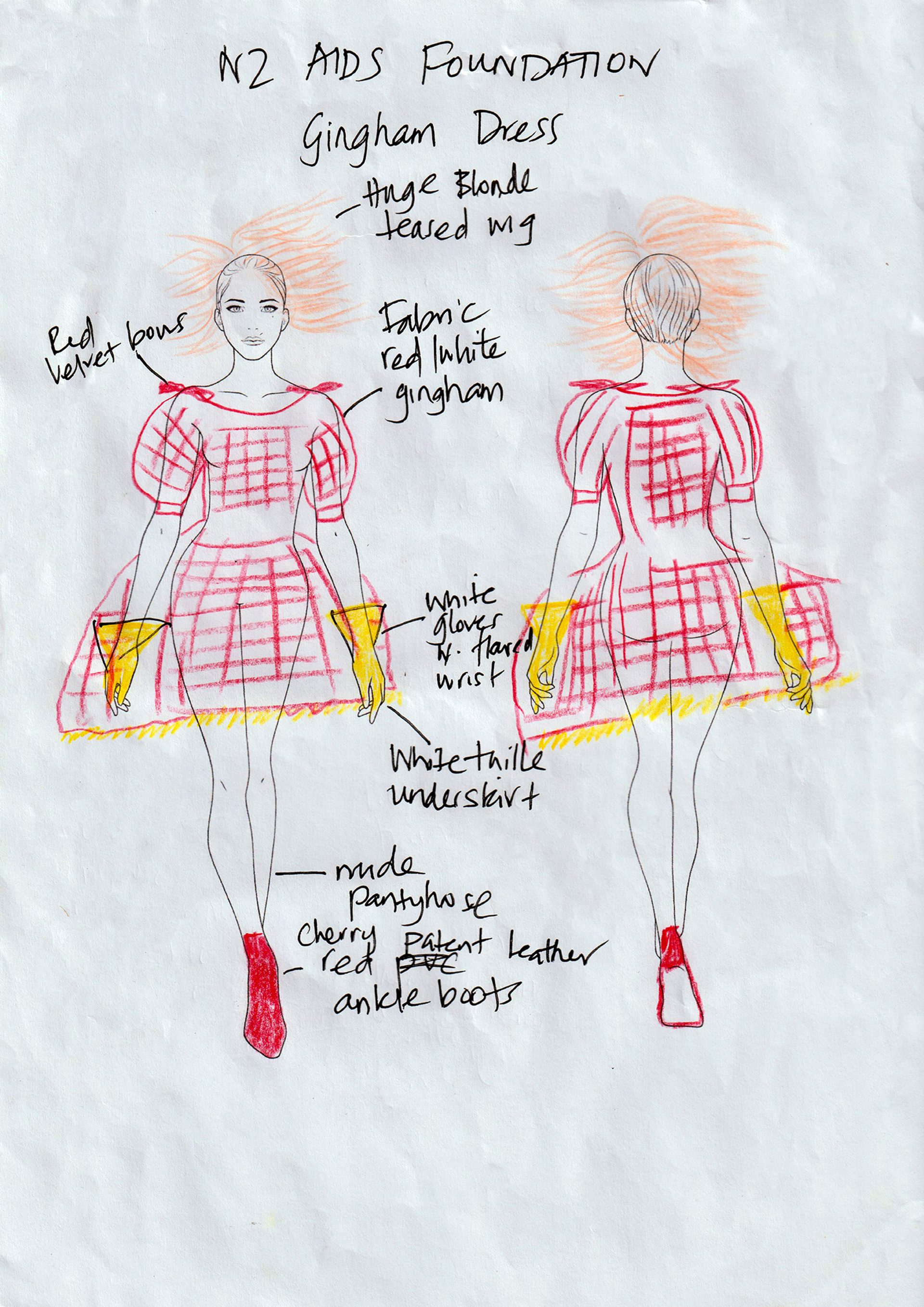
Queens of the Pacific 1994 (2023)
The gingham dress is by one of my all-time favourite designers, James Leuii.
I wore this outfit in Wellington, NZ, where I worked in the head office for the Department of Social Welfare, and it connects with my long association with the NZ AIDS Foundation. I was employed as Pacific coordinator of posters raising HIV/AIDS awareness among Pasifika peoples and promoting safe-sex practices.
Two of the posters are included in the wider Paradise Camp exhibition (see Siapo Wall). At the time, no one was creating campaigns specifically targeting Pasifika peoples. The first poster depicts young PI (Pacific Islander) people rising from the waters of the Pacific with the title, ‘Navigate Life Safely – like our Ancestors’.
The second poster focused on Fa‘afafine with Siaosi Mulipola (RIP) as the Big Fa‘afafine Goddess in the Sky, below were all the Auckland Fa’afafine I could muster for the photo call. And in the foreground, Fa‘afafine mermaids BustOp, Shanice and LacePanties, just to keep it fun.
The AFA was established in 1996 as a community action group of PI, predominantly Sāmoan, to provide education and support within the community for HIV/AIDS awareness and education. The founding members included Stephen Stehlin (Tagata Pasifika), Patrick Ah Kuoi (president), Lindah LePou (designer), Siaosi Mulipola (dancer/queen), Sefa Enari (dance educator), Sefa Fraser, Jerome Ooms and a host of others.
Despite the focus on prevention, this period was marked by the deaths of many of my dearest friends due to HIV related illnesses: Arthur Tauhore, CoCo LeCoqSucqeur (Sean McDonagh), Pussy Galore (Witoria Drak), Shuvon (David Curry), Bambi Slut (Darren Taylor), Henry Kemp and many more.
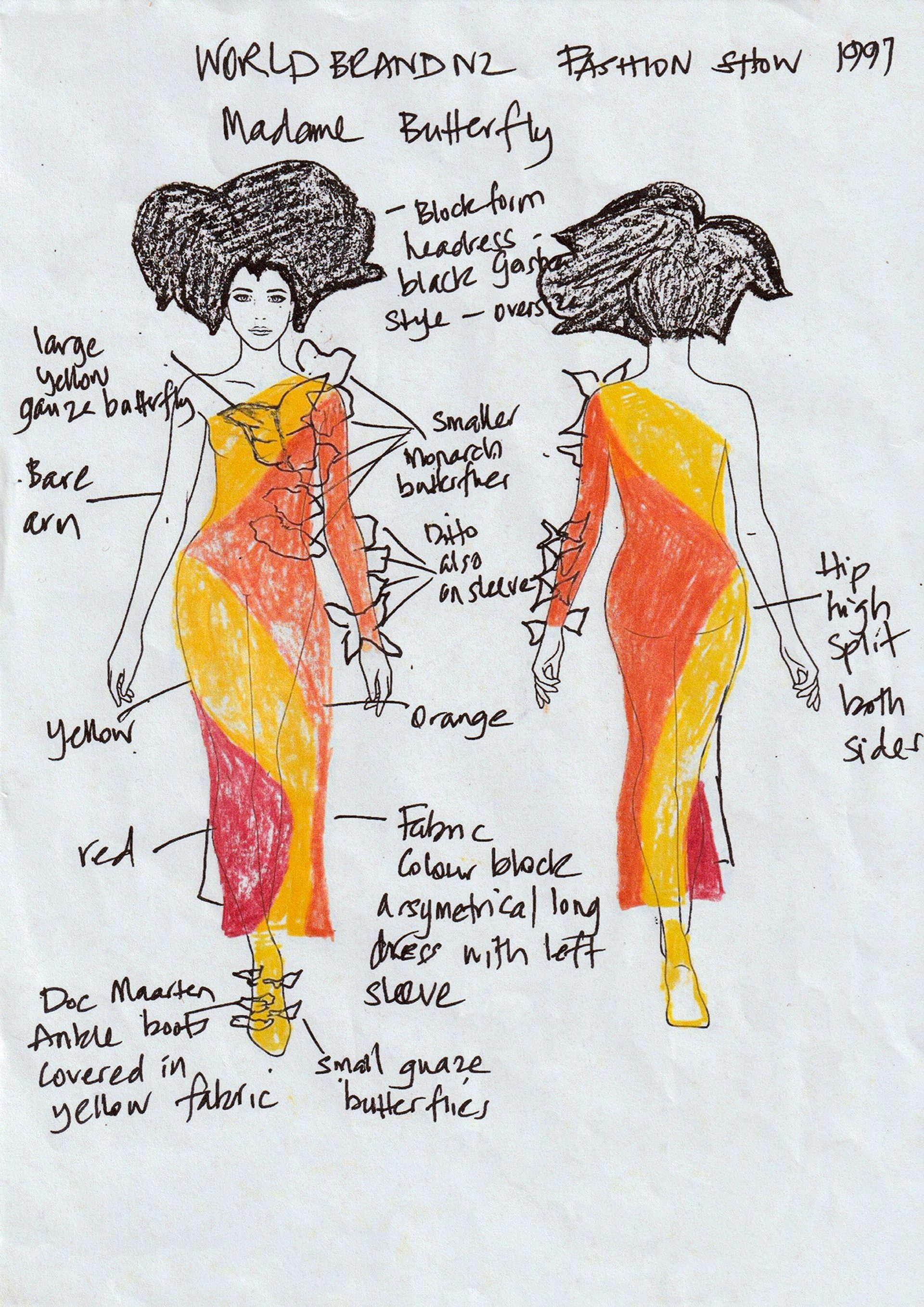
Madame Butterfly 1995 (2023)
Made by WORLD designers Francis Hooper and Denise L’Estrange-Corbet. Hair and makeup designed by Brent Lawler.
This dress was custom made as a one off.
Buckwheat and I were the first drag queens/Fa’afafine to ever appear on the runway in NZ in a major fashion event. It garnered a lot of press and the notoriety of putting two DQs on the runway paid off in terms of coverage.
This outfit signifies my long relationship with the fashion label, not just as a model but also in production managing hair and make up for various shows in New Zealand and Australian Fashion Weeks.
The actual headdress was crafted from builders’ foam which expanded when it hardened. At show time, when they went to place it on my head, they had to force it on with an almighty whack. I still have a hardened lump on my forehead from it.
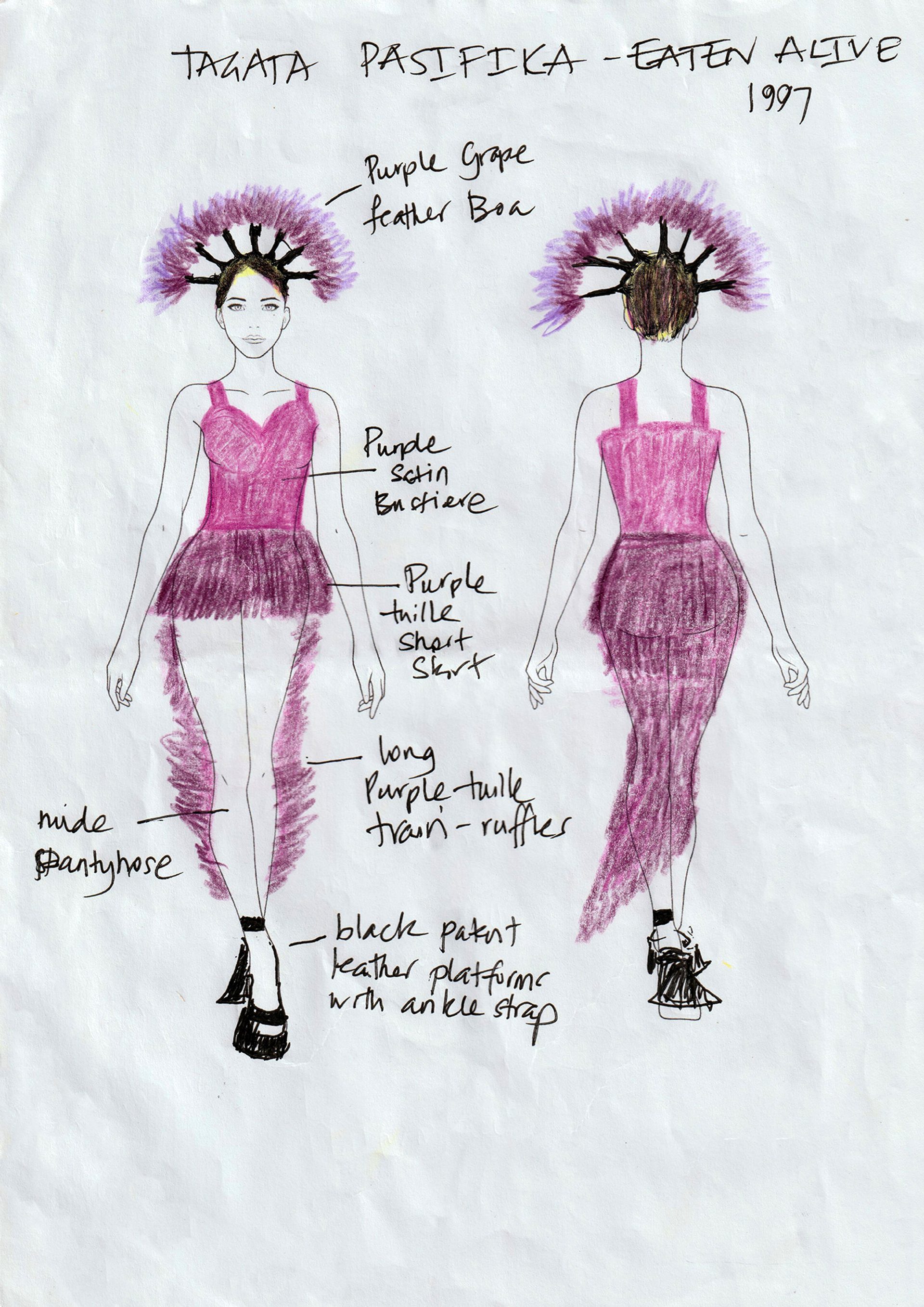
Eaten Alive 1998 (2023)
Buckwheat and Bertha hit prime time with our television foray entitled Eaten Alive. This was 10 episodes of a cooking and game show with segments produced by Stephen Stehlin for Tagata Pasifika. The segments aired each Sunday morning during its run, aimed at a Pasifika audience.
My family loved watching these segments, including my own minister Uncle, Rev Leuatea Sio who, my cousins tell, watched them religiously and laughed out loud at our antics. It was groundbreaking to have two Fa‘afafine on Sunday TV but it received a lot of criticism at the time.
This would be one of my last appearances as Bertha in New Zealand, moving to Sydney in 1998.
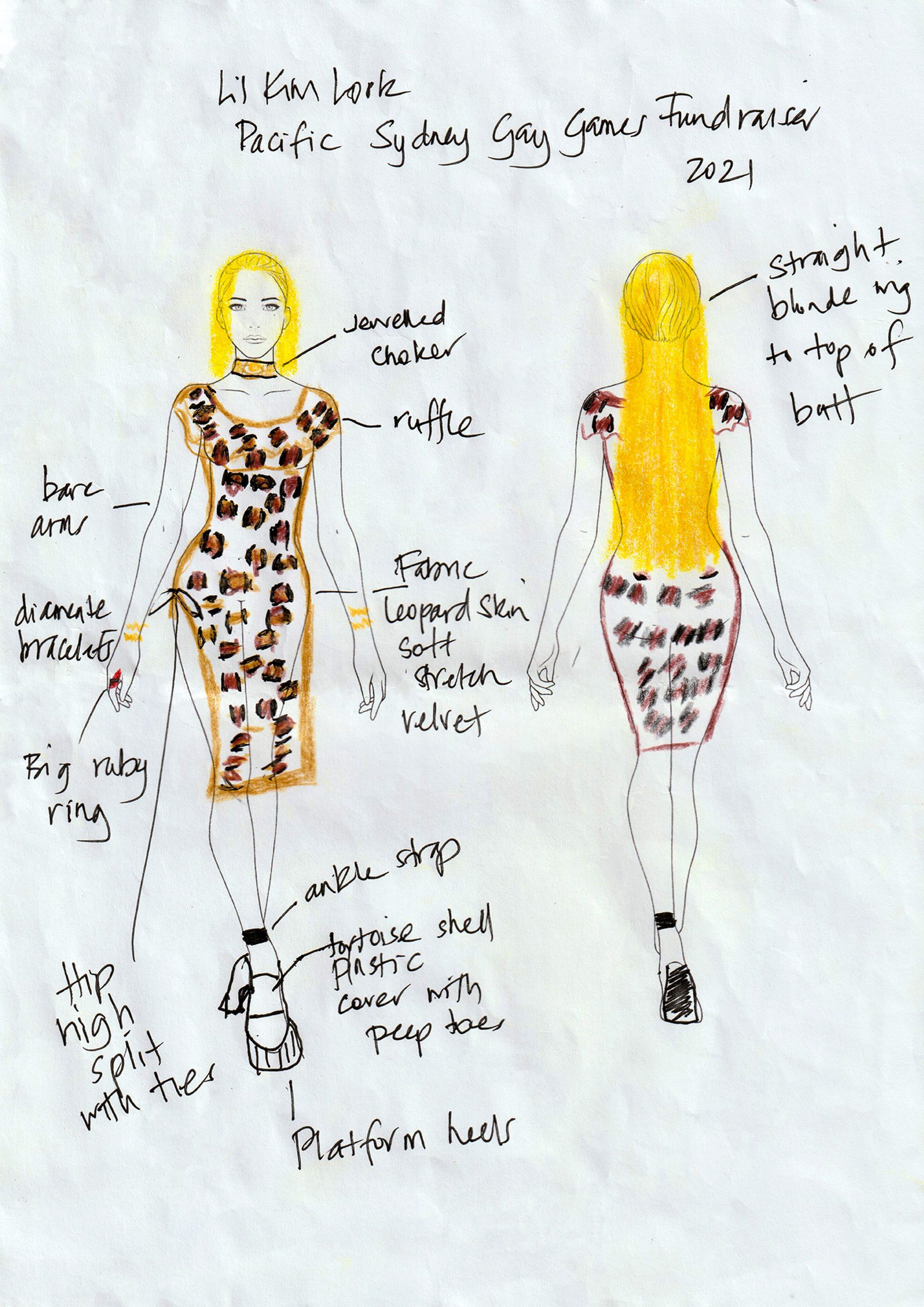
Door Bitch 2001 (2023)
This outfit was worn in 2001 during a performance in Bondi for a Gay Games Fundraiser for a Pacific Islanders collective of LGBT. We were asked to perform at a lot of fundraisers, always for free to help various community groups. Invited by Aunty Linda McDonald, our Cook Island matriarch, our posse of Sāmoan Fa‘afafine Sydney drag queens performed for the event, at which our Maori Matriarch and renowned Transexual, Carmen Rupe presided.
By this point, I had been in Sydney since July 1998. Bertha had started her performing at Annie’s Bar in Bourke St, Surry Hills, in a one drag queen show with weekly guest artists, following a long stint as door bitch/hostess at the Stonewall Hotel from 1999, facilitated by Ricca Paris, a Fa’afafine and Sydney icon, whom I’d met in NZ years before.
My mother, Molipopo Iusitini Samu, died on 7 April 2000. She was always excited to see Bertha on TV. One might even suggest she accepted Bertha more than Gay Harold. She even catered for an HIV awareness conference that I facilitated which saw the birth of the community group AFA. At the deaths of my friends to AIDS or suicide, she fronted up on all occasions with food and support. I never once thought she would die when she received a prognosis of breast cancer. Being away from home when she died is my greatest regret in life. I hadn’t actually returned to NZ since I left in 1998, until I went home for her funeral.
My dad, Lila Samu, died three years later of, I say, a broken heart. Motivated by the regret of not seeing my mum prior to her death, I managed to get home to Mangere in Auckland a few times a year before his death.

Fa‘afafines at the Sydney Opera House 2009 (2023)
Probably the pinnacle of my drag performance career was performing in a line up with Sydney’s best drag performers at a Christmas show at the Sydney Opera House. Produced by Amelia Airhead (Anthony Carthew), Buckwheat, Tess Tickle and Bertha were invited to perform as the only NZ queens in an all-Australian line up.
By this point I had all but retired from drag. My last regular gig was 2002–2004 at the Imperial Hotel hosting Monday Night Trivia with my offsider, Jamaica Hormone (RIP), who was often the brunt of my wicked tongue and humour (now an angel, but not due to my lethal wit).
In 2005 I joined the Valonz Group, a renowned company with a group of hair salons as well as editorial styling, runway styling and red carpet events. Even as a child, I had been embarrassingly addicted to playing with dolls and restyling their hair. Not the typical sort of activity for your traditional Sāmoan boy. I even used to blow-dry my young sisters’ hair with the vacuum on reverse to create some over-the-top 80s hairstyles (sorry Lina and Sera). Two of my most beloved flatmates, Arthur Tauhore in Wellington and Sean McDonagh in Auckland, were both hairdressers. So it seemed like karmic comeuppance that I now managed hair salons, albeit darned amazing salons, and hairdressers.
Out of the blue, Bucky and Tess contacted me to join them at the Sydney Opera House show. The dress is a brown-beaded, sequined sleeveless style coupled with a massive purple afro worn for the number Count On Me by Whitney Houston and Cece Wynans, a beautiful number that expresses my feelings of sisterhood toward my sister, Buckwheat (Edward Cowley). I do not consider him my brother, but more accurately, I consider him my sister.
I cannot understate the importance of the sisterhood among drag performers and Fa‘afafine. From my own sisters Buckwheat, Tess Tickle, BustOp, Shanaenae, Lindah LePou, Ramon Te Wake and Raphael Thomson, to other luminary sisters with whom I have been associated through the years: Ymania Brown-Gabriel, Phylesha Acton-Brown, Phineas Hartson, Ricca Paris, Lewis Taula, Ken Moala, Cindy of Sāmoa and so many others.
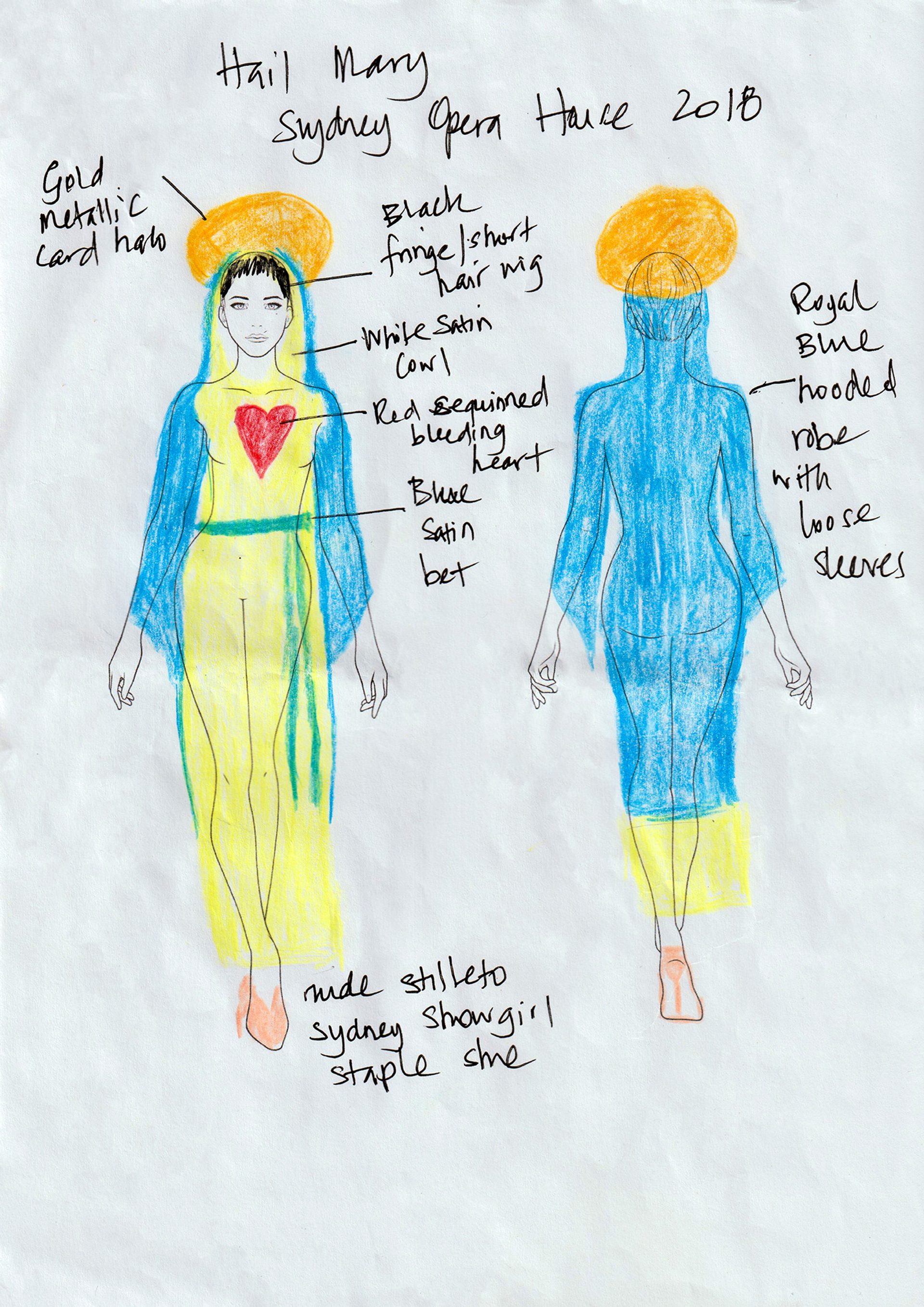
Three Marys 2010 (2023)
The indefatigable Anthony Carthew organised the show at the Sydney Opera House. Some considered it sacrilege that we were dressed as three Marys with the bleeding heart but it was water off these ducks’ backs and I’ll tell you why.
I was born and raised in the Mormon Church. I grew up meeting all the usual milestones, like baptism, priesthood, temple, Mormon high school (Church College, Hamilton, NZ), endowment (Templeview, Hamilton, NZ), two-year mission abroad (Boise Idaho Mission), and Mormon University (BYU, Hawaii).
I was serving in the Bishopric (lay member counselor to a lay preacher, called a bishop) when I was asked to counsel a woman whom I had known since childhood. I felt uncomfortable having to offer guidance and comfort when I had my own demons to deal with.
Earlier in that same summer, I had had my first gay sexual encounter. The guilt from that and the burden of hypocrisy I felt while counselling a good friend in an ecclesiastical position of counsellor was overpowering. A few days later, I was on a plane home from Hawaii back to Auckland. I had decided that the Church had to be all true or, if one thing were false, then not true at all.
I left the Church. Many Fa‘afafine have been treated unkindly in the name of religion. Only recently are we starting to be documented in any meaningful way. Not just in academia but in popular culture as well. Our Tagata Pasifika Eaten Alive show is available on YouTube.
I am still respectful of the Church and the role it plays in my family’s lives. I still attend the funerals of my beloved aunties and uncles and happily sing the hymns at the top of my vast lungs. My aiga are strong in LMS/Presbyterian, Catholic and Lotu Momona (Mormon) religions. I honour that right.
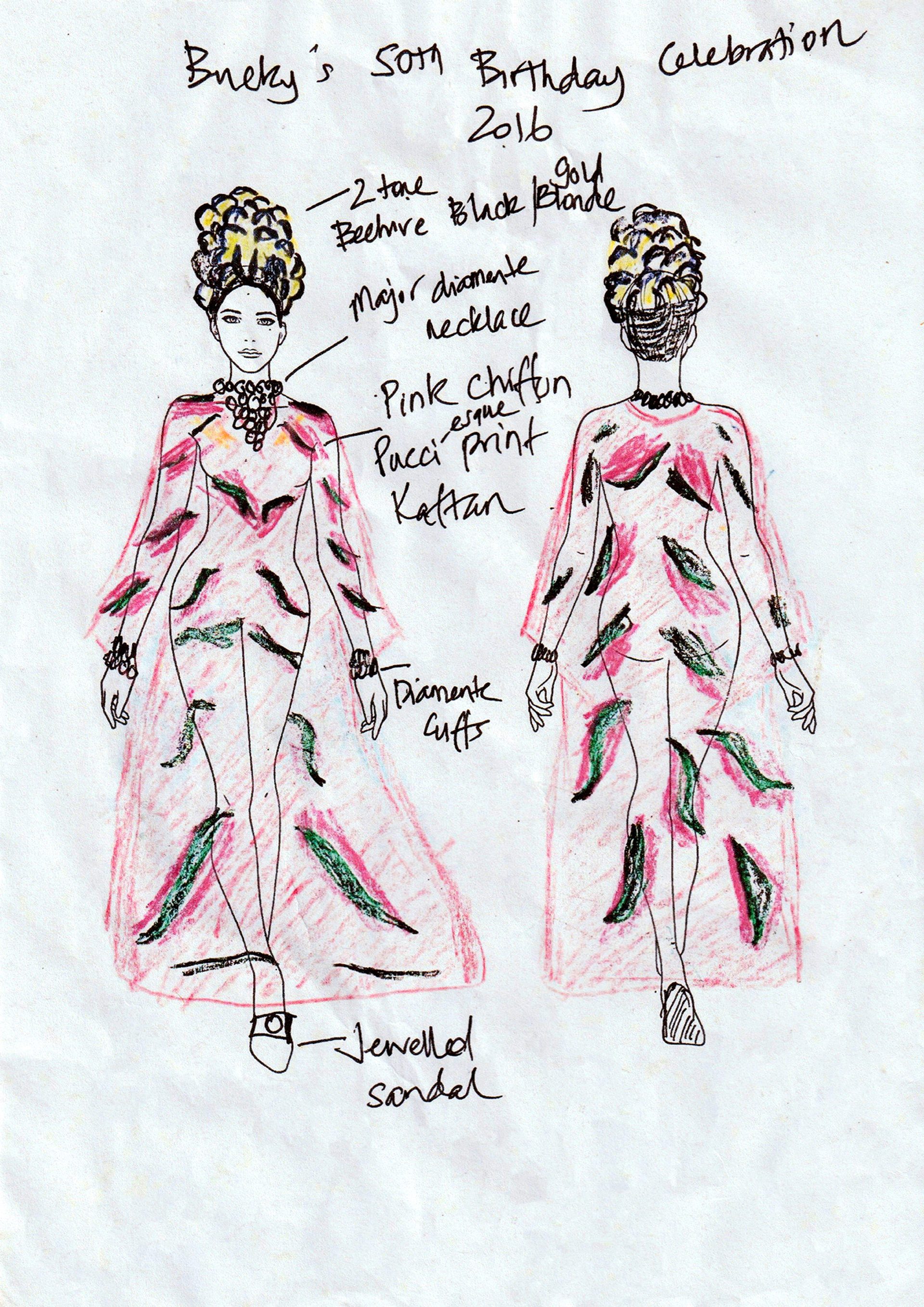
Berthaday 2016 (2023)
How did we get so old? People often say I look younger than Buckwheat but the truth is, I am a few years older than her. I flew to NZ to celebrate the 50th Berthaday (lol) of Buckwheat von Duckfeet, as I had christened her many years ago.
The fabric is a Pucci-esque treasure found in some market in Melbourne. The passage of time had not been so kind to me and now Bertha was more a Gertha, or as I had become a naturalised Australian citizen, I had joked I was now ‘Gert by Sea’. Fittingly, a kaftan was the best design to fit with my current aesthetic – fat! When I look at this image, I immediately think Mrs Doubtfire Does Downtown Apia. The celebration was held at the Maota Samoa, on K’Rd (Karangahape Road), an iconic venue for my iconic sister.
Bucky, as I call her, aka Edward Cowley, is now father to two beautiful daughters and married to his wonderful husband, Peter Browne. They have been together for as long as I’ve been in Australia, say 25 years. He has his own exhibit in the Auckland Museum, so I’m glad to finally join the club.
When we first began, we were known as the Staircase’s Buckwheat and Bertha. Staircase was a gay nightclub in Auckland from the 1980s to the early 2000s. In those days, to do drag you were usually aligned to a gay venue. We were at the height of our fame/notoriety in the 1990s. The club closed in the early 2000s.
I have, since then, suffered the feigned indignity of being invited back to perform at a succession of Staircase reunions. While it’s fun to perform again with my sisters, Buckwheat and Tess Tickle, it’s confronting to one’s mortality to be flown in as the ‘Dowager Drag Queen’.
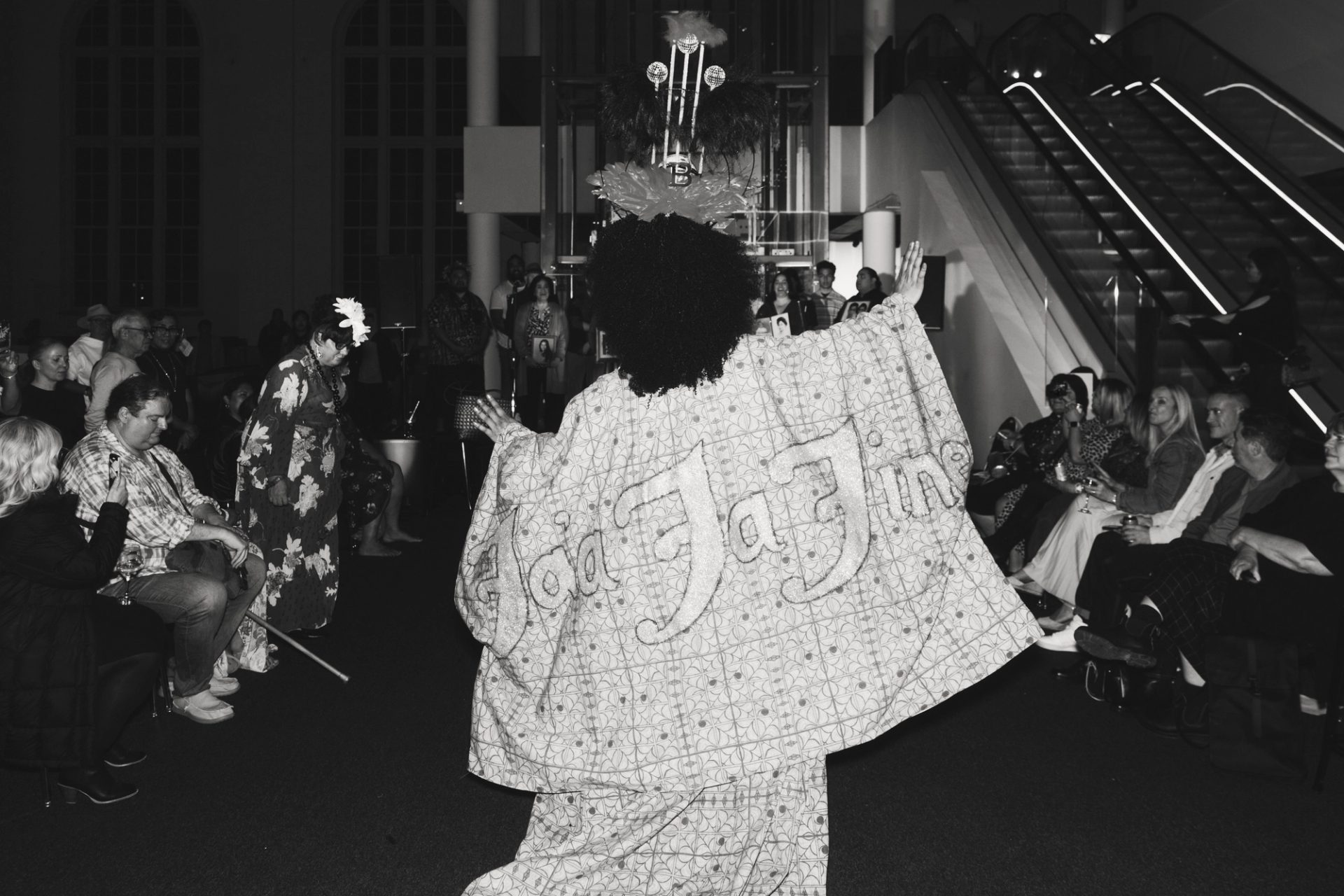
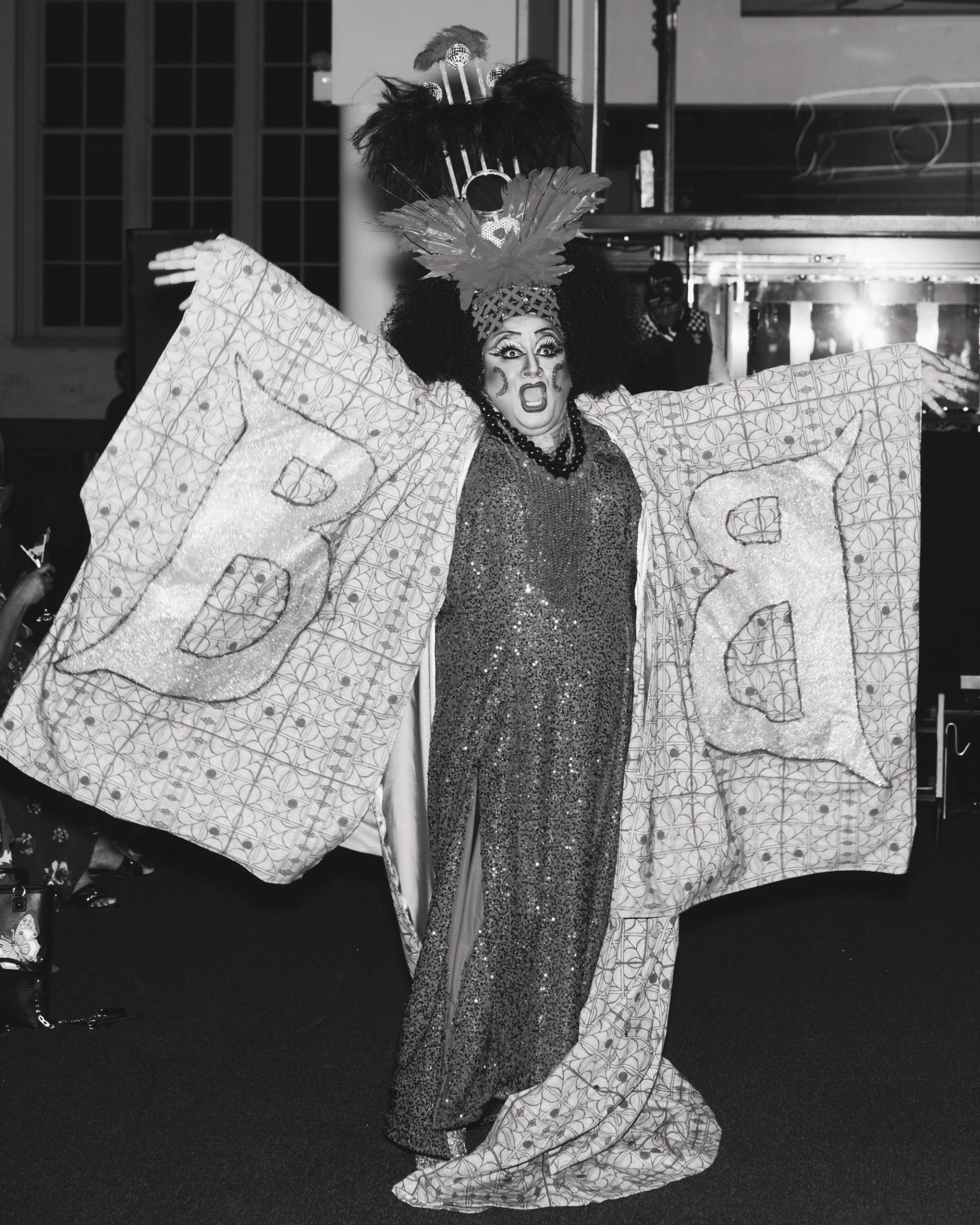
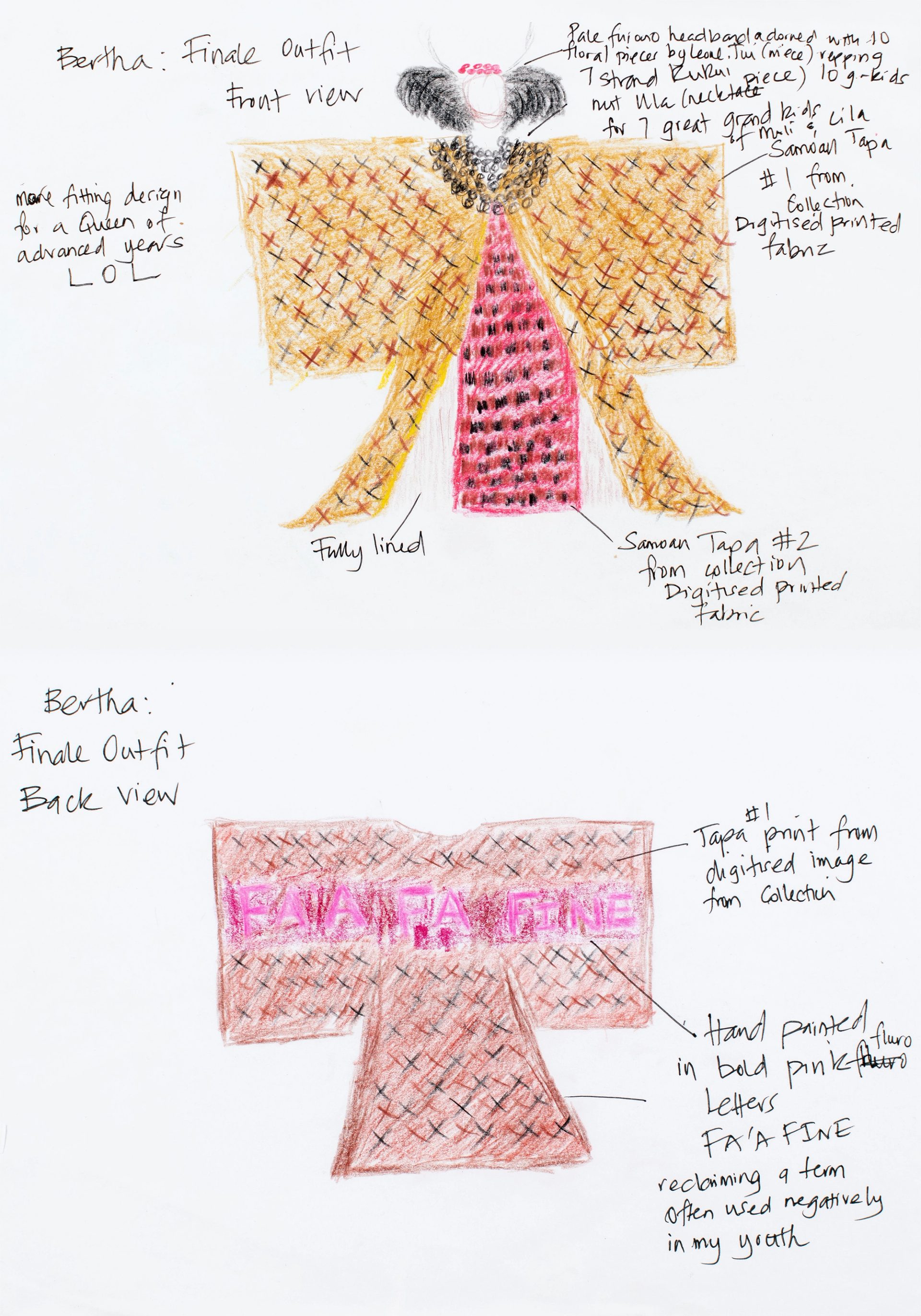
Over the Rainbow (2023)
I was so honoured when Yuki Kihara approached me to participate in this project. To be included within the Paradise Camp exhibition has given me an opportunity to incorporate some ideas and concepts I have around Fa‘afafine identity and Bertha’s relevance to the greater library of writing, film, video and performance about Fa‘afafine.
I have designed the final outfit to include a Tuiga (headdress) informed by the traditional ones worn by women and men of high standing. I’ve deconstructed the traditional design and added the elements back in a non-traditional way.
Each of element is weighted with symbolism related to factors in my life. The five pale (rods) represent the children of Moli ma Lila Samu, my sisters and brothers. The red feathers are traditionally Fijian red parrot feathers, but in the absence of rare birds, I’ve used the feathers from an old outfit.
At the base, is a jewelled heart, which was gifted by Keiren Street, editorial hair stylist, at the funeral of Chanel Logo (BustOp). Chanel had worked on all the major fashion shows in both Sydney and Auckland. As the jewelled heart couldn’t be cremated, I had put it in safekeeping until it could be used in something of sufficient importance to me, like this project.
Keiren Street and Elly Armitage have helped me with the final wig to which this Tuiga is attached. We have come full circle from our days of working on massive fashion shows. The pale fuiono (headband) is adorned with 10 frangipani earrings, which are designed by my niece Leone Tui. Each one represents the 10 grandchildren of Moli ma Lila Samu.
The central mirror is repurposed from a make-up compact. The mirror balls atop the pale rods signify that Bertha is a daughter of the Disco and will be until her dying day.
The hair swatches represent all the wigs I have worn in my life, not just because I am a drag queen but also because I am bald. I’d started losing my hair in my early 20s and, like religion, completely got rid of it once and for all in one fell swoop.
The ofu (dress) for this final doll is inspired by Yuki and Powerhouse Museum. We have taken a tapa (barkcloth) design from the Powerhouse Collection, digitised and printed it onto fabric. I selected the kimono opera coat design as a nod to Yuki's Japanese culture and her generosity in including me in this project but also because it's a silhouette that befits a woman of Bertha's advanced years and stature.
To keep it drag, I've glitter bombed it with gold glitter-fitti (drag graffiti, if you like). Two big Bs on the front which you could interpret as meaning Big Bertha but they could stand for anything you want: Bad Bitch, Big n Black etc – the list is endless.
When the kimono is viewed from the back, the word Fa‘afafine in super-size gold glitter is emblazoned across the back. Fa‘afafine: a word from which I had tried to escape as a young child, when I was caught restyling the hair of my sister's dolls, every single one of them! The whispers and the teasing at Church after Sunday school, being called Harold-dine, by the Taumoli girls, referencing Flip Wilson's drag character, Geraldine. Or the time I heard through the boarding school dorm rooms that the boys questioned why I spoke like a girl, followed by expectant giggling.
For as long as I have lived, people have often referred to the ‘dulcet tones’ of my voice. I am now proudly Fa‘afafine. I have Fa‘afafine forebears (my mother's uncles) and I have a Fa‘afafine in the generations after me. It's a strong thread through our aiga and I am proud of it.
Artist Statement
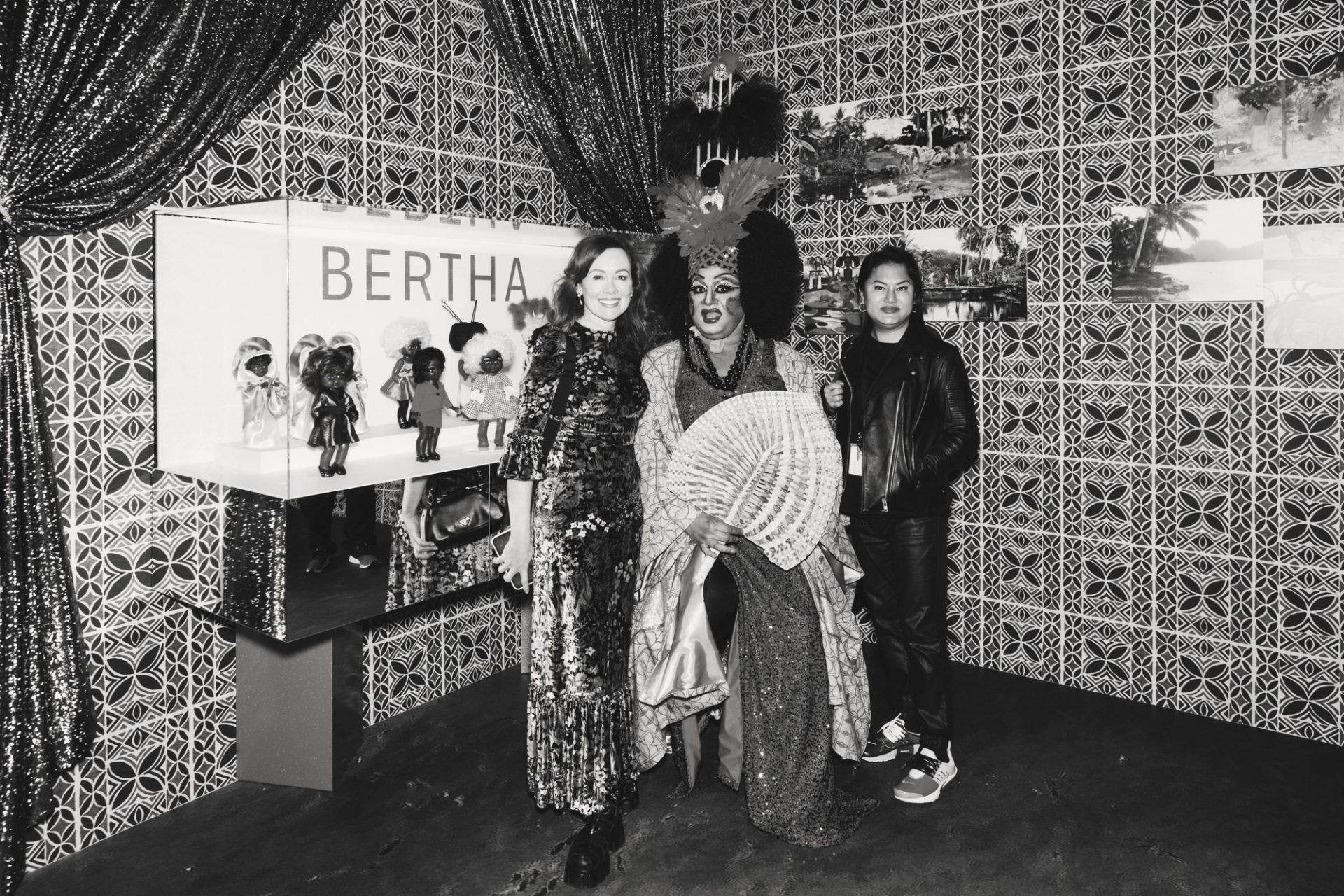
'BERTHA (2023) is my new work presented during the exhibition Paradise Camp, curated by Natalie King and commissioned by Powerhouse Museum. The commission features racialised, vintage Pacific dolls that I have collected from thrift stores and eBay over the years. The dolls have been ‘upcycled’ and repurposed to tell a larger-than-life drag story. Bertha, otherwise known as Harold Samu, played an active role in the gay nightlife and HIV/AIDS activism of the 1990s in Aotearoa New Zealand. Harold moved to Gadigal land Sydney, Australia, in early 2000 and continues to be involved in the queer community in various capacities.
In this series, I worked closely with Samu to design and recreate costumes previously worn by Bertha that capture moments in Samu’s dynamic life. These costumes are subsequently worn and represented by each doll. The series ranges from a doll entitled Law Reform Girl 1986 (2023), featuring a copper-coloured coat worn by Bertha during a march which celebrated the decriminalisation of the Homosexual Law Reform bill, to a doll entitled Eaten Alive 1998 (2023) where Bertha co-hosted a tv game show, and a doll entitled Fa’afafines at the Sydney Opera House 2009 (2023) where Bertha performed alongside a line-up of Sydney’s best drag performers during a Christmas show.
BERTHA (2023) is an extension of my previous series entitled A night to remember (2022) featuring similar dolls dressed in evening gowns worn by contestants at the first Miss Sāmoa Fa’afafine beauty pageant held in 1983 in Sāmoa. Based on the recollection of Venerable Fa’afafine Elder Galumalemana Alfred ‘Freda’ Waterhouse who was one of the contestants on the night of the pageant. Both works aim to preserve Fa’afafine stories, a strategy that I adopted in my publication entitled Samoan Queer Lives, co-edited by Dan Taulapapa McMullin.
During this second activation of Paradise Camp, opening on 24 August 2023, both Bertha and her doll will be dressed in their latest creation entitled Over the Rainbow2023 partly inspired by the siapo or Sāmoan barkcloth in the Powerhouse Collection. In the Pacific generally and Sāmoa specifically, the act of wrapping is to imbue mana or supernatural force into an object. Similarly, stripping the dolls of their former costume and wrapping them in drag oufits drawn from Samu’s life experience breathes new meaning and mana into the dolls'.
– Yuki Kihara
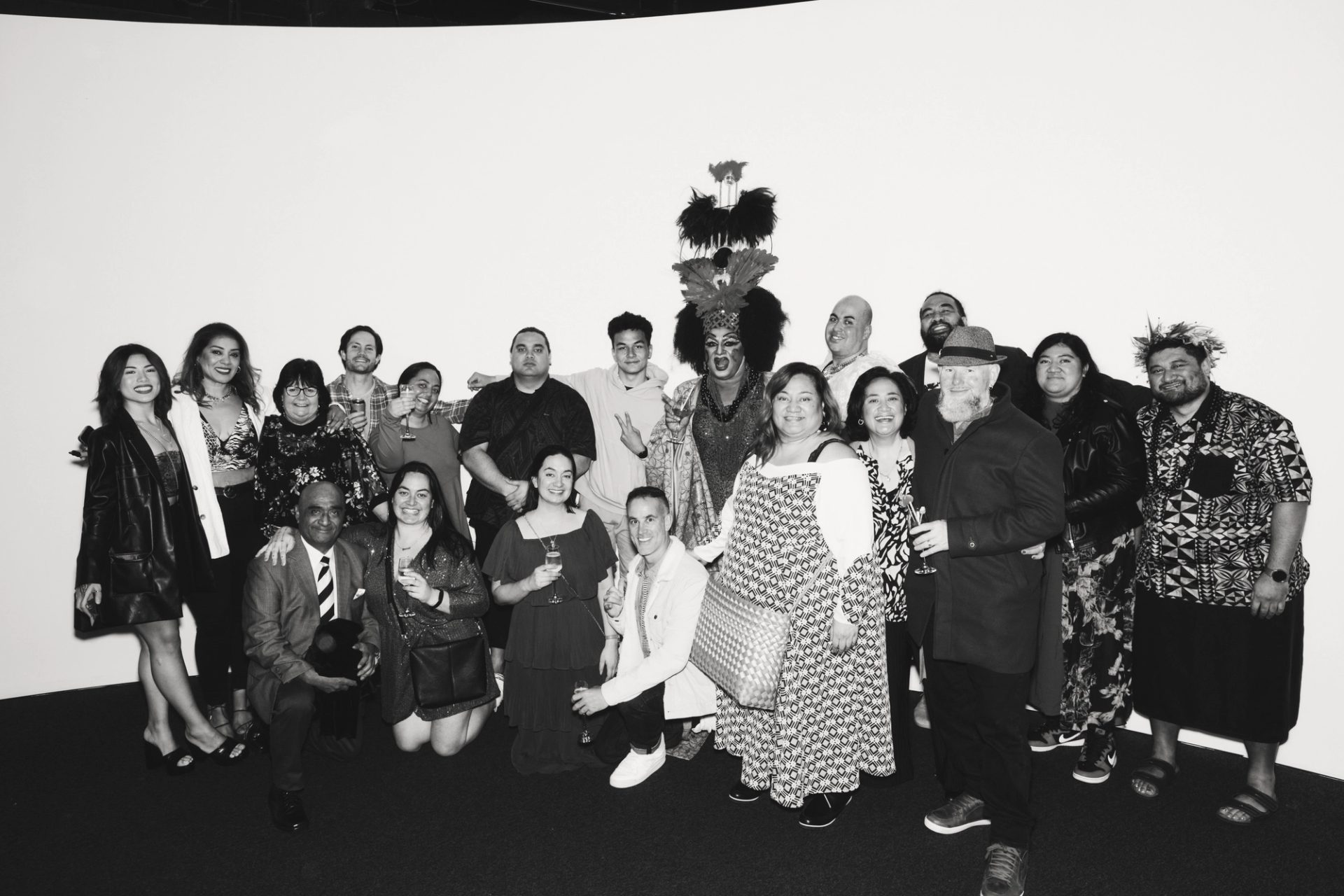
Related
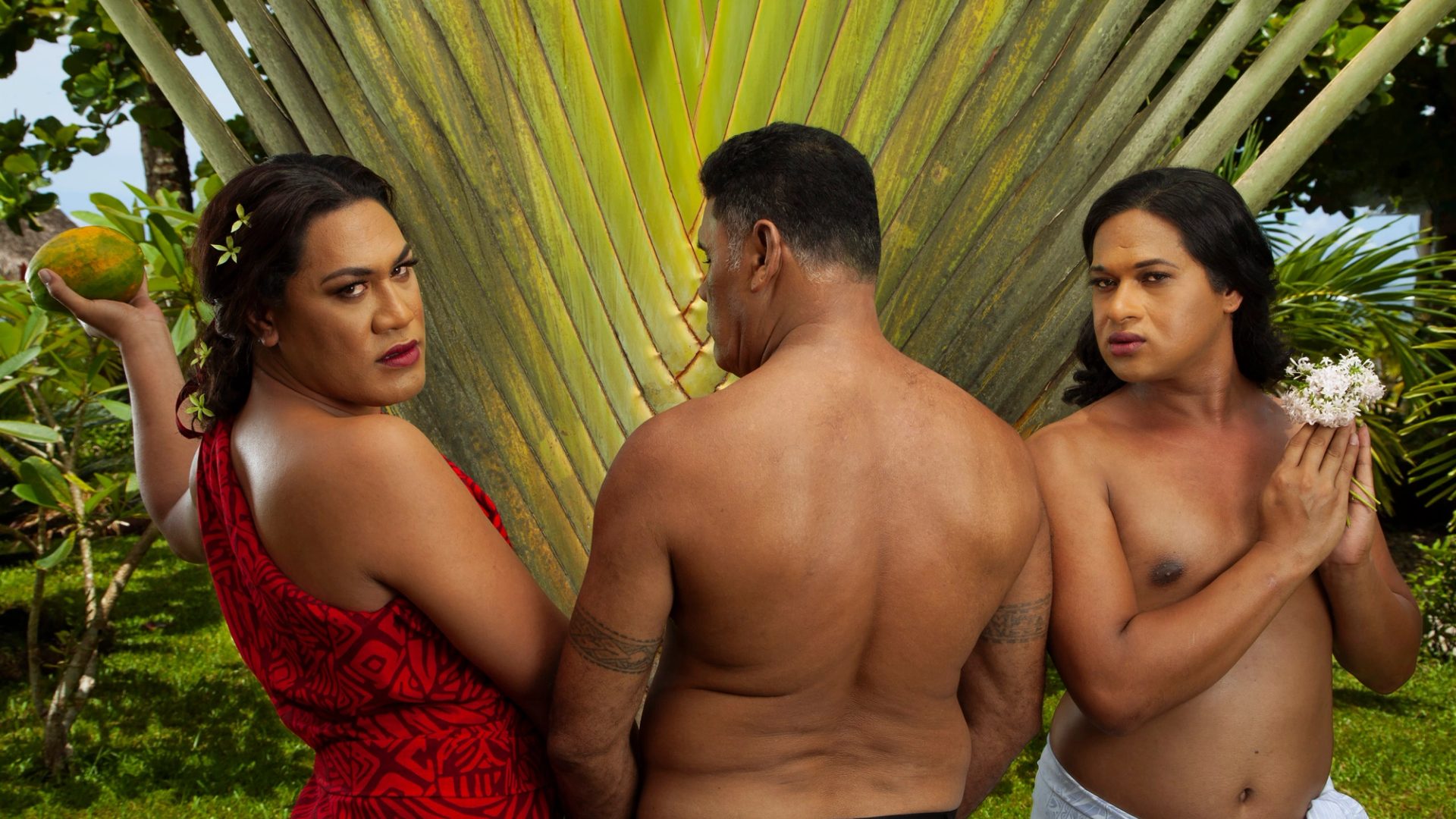
Paradise Camp
Paradise Camp was created by Yuki Kihara and curated by Natalie King. It comprises a suite of twelve tableau photographs in saturated colour, situated against a vast wallpaper of a landscape decimated by the 2009 tsunami. Eleven of the works were shot on location in Sāmoa, from rural villages to churches, plantations and heritage sites, with a local cast and crew of over eighty people.
More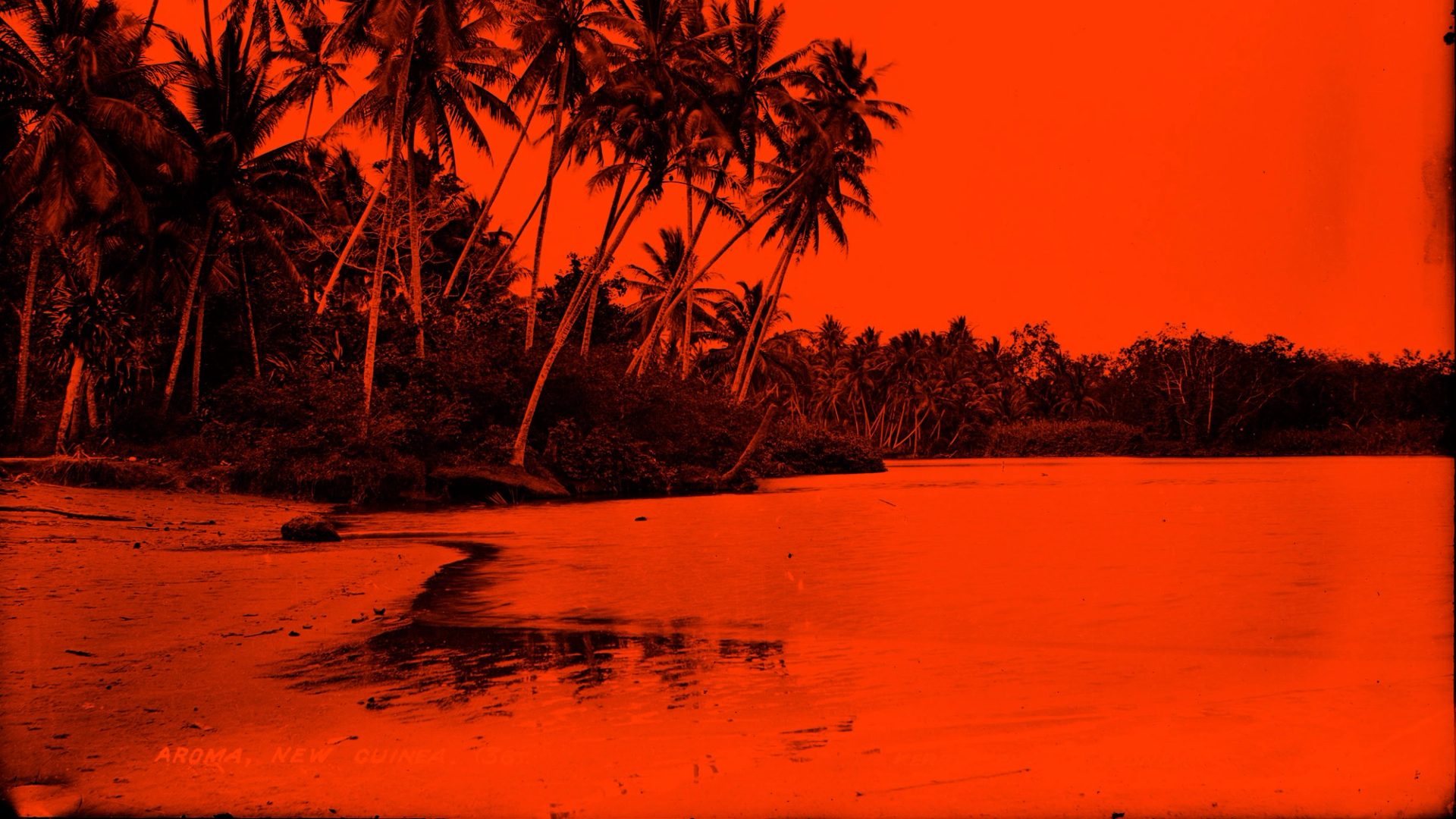
Talanoa Forum: Moana Rising
First presented at the 59th Venice Biennale, the Talanoa Forum extends the themes of the Paradise Camp exhibition by bringing together 24 artists, curators, scholars, activists and policymakers from Australia, Aoteroa New Zealand, Sāmoa, Tahiti, and Italy. Over three days, this interdisciplinary program will highlight urgent issues around small island ecologies, climate justice, decolonial museology, diasporic and Pacific alliances.
More









